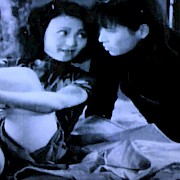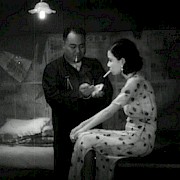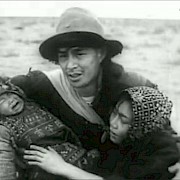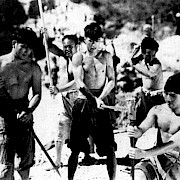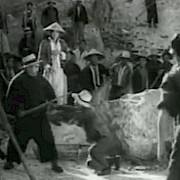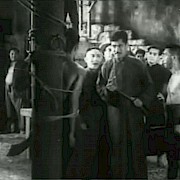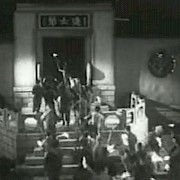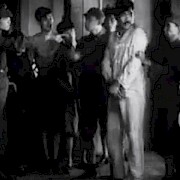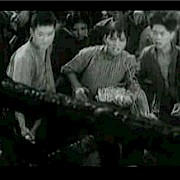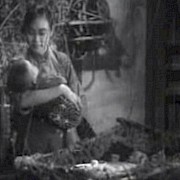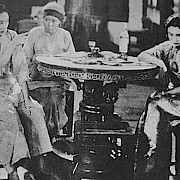First Previous Next Last
The Myth about Chinese Leftist Cinema
Zhiwei Xiao
Images
Figure 8.1
One of the many stereotypes in the arsenal of racist fantasy images from Hollywood films in the first half of the 20th century was the portrayal of the diabolical Asian villains by white actors in "yellow face." Here Boris Karloff plays the evil Dr. Fu Manchu from the 1932 film, the Mask of Dr. Fu Manchu. Source: Film still, courtesy of MPTV.
Figure 8.2
The diabolical villain was not the only Asian stereotype that filled the screens of Hollywood films; there was also a stereotype of Chinese as poor, backward, traditionalistic and preternaturally submissive, as rather unfit to comprehend or function effectively in a modern world. This more somewhat sympathetic but still often offensive stereotype could be found in films like The Good Earth from which this publicity still is taken, again with white actors in yellow-face. Though the film was in many ways effective creating sympathy for the Chinese among U.S. audiences, the Chinese government at the time found its portrayal of Chinese offensive. Source: Yellow-face.com. Fair use.
Figure 8.3
A still from the 27 hour long film series The Burning of Red Lotus Temple (Huo shao Hongliansi, dir. Zhang Shichang) The 19 silent films of this series were released by the Mingxing film company between 1928 and 1931 and no copies survive, but this image captures magical special affects where several warriors battle with flying swords. Films with such special effects and magical spectacle were extremely popular in Chinese cities in the 1920s and 1930s but often criticized by elites and the target of censorship.Figure 8.4
The images removed from films due to state or self-censorship in the Republican era are lost to history, but this still from The Empress or Sports (Tiyu Huanghou, dir. Sun Yu, 1934), with actress Li Lili showing off her shapely and extremely healthy legs (she plays a track star in the film) is typical of the limits of risqué displays of the female body of the time period. The film (with Chinese but no English subtitles) can be found at https://www.youtube.com/watch?v=KdUuHMET26MFigure 8.5
This still from the film The Goddess (1934) is as far as the censors allowed director Wu Yonggang to get in showing Ruan Lingyu working as a prostitute. After this frame the film immediately cuts to Ruan Lingyu emerging from the front door of a hotel the following morning. The film can be found with English subtitles at https://www.youtube.com/watch?v=y_DXMCrB5Q8Figure 8.5b
In this still from The Goddess, Ruan Lingyu’s character is shown smoking a cigarette with a thug who has designs on becoming her abusive pimp. Though this picture does not appear highly sexually suggestive to our eyes, it was one of the more sexually charged images from the film.Figure 8.6
The following images selected from the film Big Road have been chosen to convey the how difficult it was (and is) to nail down the ideological meanings of a particular film or image in a film as “leftist” or not. Potentially leftist themes, like the unjust suffering of the poor and the oppression of workers by corrupt officials and bosses, certainly feature prominently in the film. Figure 8.6 – 8.6e include: a poor peasant family fleeing famine (the scene ends with the mother’s death); road workers embracing their strenuous labor; a boss about to beat a sick worker, surrounded by an angry crowd of laborers who will eventually cow the boss into relenting; the brave leaders of the road crew bound in their boss’s dungeon and about to be whipped; and a mob of torch-carrying road workers storming their traitorous boss’s mansion. All these images could be interpreted as potentially fanning Leftist sentiments against economic oppression and the corruption of the ruling class. On the other hand, the GMD Nationalist Party military comes into the film at the end as the ultimate hero, capturing the traitorous boss (see Figure 8.6f) and leading the workers to complete a road much needed for China’s national defense, even in the face of enemy attack. The film can be found with English subtitles on at https://www.youtube.com/watch?v=6pgTAjzSgDIFigure 8.7
Images of tragic poverty abound in many 1930s films, but government censor’s opinions about their ideological implications could vary greatly and change with political circumstances. Should such images be treated as realistic and touching portrayals of some of China’s realities meant to stir a desire for a stronger modern nation? Or were they attacks on the governments failures? Might such images be used as justifications for Japanese intervention in a failing China? Were they embarrassing portrayals of China that the rest of the world should not be shown?This still from Song of the Fishman captures one of many tragic moments: two youths, have finally gotten food to feed their ailing starving mother, return to find she has just died in her hovel of a home, too ill to stop the kitchen fire from consuming her wood and grass shack. The film can be found (though without English subtitles) at https://archive.org/details/song_of_the_fishermen
Figure 8.7b
Portrait of poverty from another film, Twin Sisters (1934). Here we see the poor sister Dabao caring for her two children (one resting an a hammock made of grasses and reads. Neither her bedridden mother nor tubercular husband can work, so Dabao will soon have to leave her children to seek work in the city as a maid. From https://archive.org/details/twinsistersFigure 8.8
Still from the climax of the film Twin Sisters (Zai sheng hua) in which the two sisters played by Hu Die share the screen. The film touches on many of China’s social problems in the 1930s, including the disparities between rich and poor and the high-handed treatment of the poor by the rich. The above image is a good example of representations that raises these class tensions but is certainly far from a clear promotion of class revolution or an unequivocal “leftist” message. Twin Sisters can be found on the Internet (though without English subtitles) at https://archive.org/details/twinsistersChapter Sample
A film’s meaning is often defined less by its supposed “intrinsic” qualities than by the circumstance under which it is viewed. To take an example from American film: from the 1910s through the 1960s many Asian characters were played by white actors in “yellow face.” While certainly viewed as offensive by most Asians and minority audiences at the time, the majority of white film viewers were generally unperturbed by these highly stereotypical and degrading portrayals of Asians; today we are immediately struck by the obvious racial prejudice of such images (Figure 8.1 below and Figure 8.2). The issues in Chinese film history are, as we will see in this essay, quite different; but the central point, that the context in which a film is viewed is often even more important than its intrinsic content—that audience reception is often as important as image production—lies at the crux of this chapter. A distinction must be made between what films meant to their audiences at the time of initial release and what their future viewers read into them in later years, for these interpretations are often divorced from the experience of the moviegoers of the past.
I argue in this chapter that the labeling of a large number of 1930s Chinese films as “leftist” in current Chinese film historiography distorts historical reality. By projecting an unambiguous political reading onto these films, the label ignores the complexity of the relationship between the Chinese film industry and the Nationalist (GMD) government, disregards the political context in which these films were made, and excludes other interpretative possibilities. As I will show: 1) the so-called leftist films were often consistent with the Nationalist government’s policies; 2) indeed, if there was an oppositional thrust in these films, that thrust had more to do with shifting political circumstances than with any conscious “leftist” positioning of the filmmakers and 3) the myth about leftist cinema was manufactured in post-1949 China by a group of people to serve their own political agenda rather than for historical accuracy. All three of these points highlight that the changing context of reception, not the intrinsic content of the celluloid images themselves, has played a primary role in shaping how many Republican-era Chinese films have been understood.
Further Reading
Berry, Chris, “Chinese left cinema in the 1930s: Poisonous weeds or national treasures” in Jump Cut 34 (March, 1989): 87-94.
Lee, Leo Ou-fan. "The Urban Milieu of Shanghai Cinema, 1930-40: Some Explorations of Film
Audience, Film culture, and Narrative Conventions." In Yingjin Zhang, ed., Cinema and Urban
Culture in Shanghai, 1922-1943, Stanford: Stanford University Press, 1999, 74-96.
Ma, Ning, “The Textual and Critical Difference of Being Radical: Reconstructing Chinese Leftist Films of the 1930s,” Wide Angle 11, no. 2 (1989): 22-31.
Pang, Lai-kwan, Building a New China in Cinema: The Chinese Left-Wing Cinema Movement, 1932-1937, Rowman & Littlefield Publishers, 2002.
Pickowicz, Paul G., “The Theme of Spiritual Pollution in Chinese Films of the 1930s” in Modern China, 17, no. 1 (Jan., 1991): 38-75.
Pickowicz, Paul. “Melodramatic Representation and the 'May Fourth' Tradition of Chinese Cinema.” In Ellen Widmer and David Wang, eds., From May Fourth to June Fourth: Fiction and Film in Twentieth-Century China, Cambridge: Harvard University Press, 1993, pp. 295-326.
Shen, Vivian, The origins of left-wing cinema in China, 1932-37, New York: Routledge, 2005.
Study Questions
1. What was the historical circumstance under which the issue of “leftist cinema” emerged? To what extent does the discourse about leftist cinema reflect the political and ideological antagonism between the Nationalists and the Communists, and to what extent does it reflect power struggles and factionalism within each of those parties?
2. Based on the cases discussed in this chapter, how was/ is a film identified as “leftist?” Is the intrinsic quality of a given film (thematic orientation, subject matter, and use of political vocabularies) or the filmmaker’s political affiliation more important in a film being viewed as leftist? What should we make of the fact that the Nationalist government in the 1930s gave official endorsement and approval to a large number of films that are regarded today as leftist classics in Communist film historiography?
3. What explains the fact that the label “leftist film” has been applied to more and more films from the 1930s in post-1949 China? In what ways has the teleological reading of films from the past distorted our understanding of the so-called leftist cinema movement?
4. Find a film discussed in this chapter on the Internet (many of them can be found in their entirety on the Internet, occasionally with English subtitles on Youtube or at https://archive.org/).
Can you find scenes, images or dialogue in the films that could be interpreted as conveying sympathy with Chinese Communist Party ideologies from the 1930s? What about ones that convey support for the Nationalist GMD government? What about explicit expressions of support for the CCP or explicit criticisms of the GMD? What about expressions of national pride that have no direct connection to Party affiliations?
Recall also that censors in the 1920s and 1930s also focused on other issues like superstition and sex. Can you find scenes, images or dialogue that convey sensitivity to key issues like: Modern ideas about science, public health and proper modern hygiene? The rejection of superstition? Expressions of sexuality?




